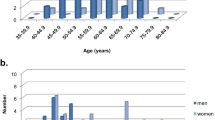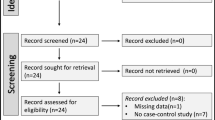Abstract
Amyloidosis is the major complication of familial Mediterranean fever (FMF). Toll-like receptors (TLR) are involved in the activation of an innate immune system TLR-2 and TLR-4 recognize lipoteichoic acid and lipopolysaccharides (LPS), respectively. While TLR-2 Arg753Gln polymorphism upregulates, TLR-4 Asp299Gly and Thre399Ile polymorphisms downregulate inflammation. We investigated the effect of these polymorphisms on the development of amyloidosis in FMF patients. We also investigated myeloid cell TLR-2 and TLR-4 expressions in these patients. We studied 26 FMF patients and 13 FMF patients with amyloidosis. TLR-2 Arg753Gln and TLR-4 Asp299Gly and Thr399Ile polymorphisms were analyzed with the polymerase chain reaction-restriction fragment length polymorphism method. Myeloid cell baseline TLR-2 and TLR-4 and LPS-induced TLR-4 expressions were evaluated. The TLR-2 and TLR-4 polymorphism rate was compared with the results of 100 healthy subjects in our previous study. In addition, 13 healthy controls were enrolled for leukocyte TLR-2 and TLR-4 expressions. Serum amyloid A (SAA) levels were measured in these 13 control cases and in FMF patients during attack-free periods. The frequency of TLR-2 Arg753Gln, TLR-4 Asp299Gly, and Thr399Ile polymorphisms in healthy controls in our previous study were 1%, 3%, and 2%, respectively. The frequency of these polymorphisms were not different in FMF patients (with or without amyloidosis) compared to the control group. Likewise, myeloid cell TLR-2 and TLR-4 expressions were not different among the controls and FMF patients. However, LPS-induced TLR-4 expression in granulocytes was more prominent in FMF patients. There was no correlation between TLR-2 and TLR-4 expressions and SAA levels. Neither myeloid cell TLR-2 and TLR-4 expressions nor TLR-3 Arg753Gln, TLR-4 Asp299Gly, and Thr399Ile polymorphisms seem to affect the development of secondary amyloidosis in FMF patients in our study population.


Similar content being viewed by others
REFERENCES
Tunca, M., S. Akar, F. Onen, et al. 2005. Familial Mediterranean fever (FMF) in Turkey: Results of a nationwide multicenter study. Medicine (Baltimore) 84: 1–11.
Centola, M., G. Wood, D.M. Frucht, et al. 2000. The gene for familial Mediterranean fever, MEFV, is expressed in early leukocyte development and is regulated in response to inflammatory mediators. Blood 95: 3223–3231.
Bagci, S., B. Toy, A. Tuzun, et al. 2004. Continuity of cytokine activation in patients with familial Mediterranean fever. Clinical Rheumatology 23: 333–337.
Oktem, S., T.U. Yavuzsen, B. Sengul, H. Akhunlar, S. Akar, and M. Tunca. 2004. Levels of interleukin-6 (IL-6) and its soluble receptor (sIL-6R) in familial Mediterranean fever patients and their first degree relatives. Clinical and Experimental Rheumatology 22(Suppl 34): S34–S36.
Yamada, T., Y. Okuda, and Y. Itoh. 1998. The frequency of serum amyloid A2 alleles in the Japanese population. Amyloid 5: 208–211.
Ben-Chetrit, E. 2003. Familial Mediterranean fever (FMF) and renal AA amyloidosis: Phenotype-genotype correlation, treatment and prognosis. Journal of Nephrology 16: 431–434.
Takeda, K., and S. Akira. 2005. Toll-like receptors in innate immunity. Inter Immunol 17: 1–14.
Schroder, N.W.J., and R.R. Schumann. 2005. Single nucleotide polymorphisms of Toll-like receptors and susceptibility to infectious disease. The Lancet Infectious Diseases 5: 156–164.
Samuelsson, P., L. Hang, B. Wullt, H. Irjala, and C. Svanborg. 2004. Toll-like receptor 4 expression and cytokine responses in the human urinary tract mucosa. Infection and Immunity 72(6): 3179–3186.
Cook, D.N., D.S. Pisetsky, and D.A. Schwartz. 2004. Toll-like receptors in the pathogenesis of human disease. Nature Immunology 5: 975–979.
Berdeli, A., H.A. Celik, R. Ozyurek, B. Dogrusoz, and H.H. Aydin. 2005. TLR-2 gene Arg753Gln polymorphism is strongly associated with acute rheumatic fever in children. Journal of Molecular Medicine 83: 535–541.
Ozen, S., A. Berdeli, B. Türel, et al. 2006. Arg753Gln TLR-2 polymorphism in familial Mediterranean fever: Linking the environment to the phenotype in a monogenic inflammatory disease. The Journal of Rheumatology 33: 2498–2500.
Montes, A.H., V. Asensi, V. Alvarez, et al. 2006. The Toll-like receptor 4 (Asp299Gly) polymorphism is a risk factor for Gram-negative and haematogenous osteomyelitis. Clinical and Experimental Immunology 143: 404–413.
Arbour, N.C., E. Lorenz, B.C. Schutte, et al. 2000. TLR4 mutations are associated with endotoxin hyporesponsiveness in humans. Nature Genetics 25: 187–191.
Schmitt, A. Humeny, C.M. Becker, K. Brune, and A. Pahl. 2002. Polymorphisms of TLR4: Rapid genotyping and reduced response to lipopolysaccharide of TLR4 mutant alleles. Clinical Chemistry 48: 1661–1667.
Ferwerda, B., M.B. McCall, S. Alonso, et al. 2007. TLR4 polymorphisms, infectious diseases, and evolutionary pressure during migration of modern humans. Proceedings of the National Academy of Sciences of the United States of America 104: 16645–16650.
Livneh, A., P. Langevitz, D. Zemer, S. Kees, and T. Lidar. 1997. Criteria for the diagnosis of familial Mediterranean fever. Arthritis and Rheumatism 40: 1879–1885.
Soylu, A., S. Kızıldağ, S. Kavukçu, S. Cingöz, M. Türkmen, B. Kasap Demir, and M. Sakızlı. 2010. TLR-2 Arg753Gln, TLR-4 Asp299Gly, and TLR-4 Thr399Ile polymorphisms in Henoch Schonlein purpura with and without renal involvement. Rheumatology International 30: 667–670.
Brandl, K., T. Gluck, C. Huber, B. Salzberger, W. Falk, and P. Hartmann. 2005. TLR-4 surface display on human monocytes is increased in septic patients. European Journal of Medical Research 10: 319–324.
Schroder, N.W., C. Heran, L. Hamann, U.B. Gobel, T. Hartung, and R.R. Schumann. 2003. High frequency of polymorphism Arg753Gln of the Tollike rceptor-2 gene detected by a novel allele-specific PCR. Journal of Molecular Medicine 81: 368–372.
Lorenz, E., K.L. Frees, and D.A. Schwartz. 2001. Determination of the TLR4 genotype using allele-specific PCR. Biotechniques 31: 22–24.
Samuels, J., I. Aksentijevich, Y. Torosyan, et al. 1998. Familial Mediterranean fever at the millennium. Clinical spectrum, ancient mutations, and a survey of 100 American referrals to the National Institutes of Health. Medicine (Baltimore) 77: 268–297.
Cattan, D. 2005. MEFV mutation carriers and diseases other than familial Mediterranean feer: Proved and non-proved associations; putative biological advantage. Current Drug Targets. Inflammation and Allergy 4: 105–112.
Lachmann, H.J., B. Sengul, T.U. Yavuzsen, et al. 2006. Clinical and subclinical inflammation in patients with familial Mediterranean fever and in heterozygous carriers of MEFV mutations. Rheumatology (Oxford) 45: 746–750.
Ozen, S., B. Balci, S. Ozkara, et al. 2002. Is there a heterozygote advantage for familial Mediterranean fever carriers against tuberculosis infections: Speculations remain? Clinical and Experimental Rheumatology 20(Suppl 26): S57–S58.
Snelgrove, T., S. Lim, C. Greenwood, et al. 2007. Association of toll-like receptor 4 variants and ankylosing spondylitis: A case-control study. The Journal of Rheumatology 34: 368–370.
van der Graaf, C.A., M.G. Netea, S.A. Morré, et al. 2006. Toll-like receptor 4 Asp299Gly/Thr399Ile polymorphisms are a risk factor for Candida bloodstream infection. European Cytokine Network 17: 29–34.
Emingil, G., A. Berdeli, H. Baylas, et al. 2007. Toll-like receptor 2 and 4 gene polymorphisms in generalized aggressive periodontitis. The Journal of Periodontology 78: 1968–1977.
Saatçi, U., S. Ozen, S. Ozdemir, A. Bakkaloglu, N. Besbas, R. Topaloglu, and S. Arslan. 1997. Familial Mediterranean fever in children: Report of a large series and discussion of the risk and prognostic factors of amyloidosis. European Journal of Pediatrics 156: 619–623.
Yalçinkaya, F., N. Cakar, B. Acar, et al. 2007. The value of the levels of acute phase reactants for the prediction of familial Mediterranean fever associated amyloidosis: A case control study. Rheumatology International 27: 517–522.
Duzova, A., A. Bakkaloglu, N. Besbas, et al. 2003. Role of A-SAA in monitoring subclinical inflammation and in colchicine dosage in familial Mediterranean fever. Clinical and Experimental Rheumatology 21: 509–514.
Conflicts of interest
None.
Author information
Authors and Affiliations
Corresponding author
Additional information
The study was supported by TUBITAK (Scientific and Technological Research Council of Turkey).
Rights and permissions
About this article
Cite this article
Soylu, A., Ateş, H., Cingöz, S. et al. TLR Polymorphisms in FMF: Association of TLR-2 (Arg753Gln) and TLR-4 (Asp299Gly, Thre399Ile) Polymorphisms and Myeloid Cell TLR-2 and TLR-4 Expression with the Development of Secondary Amyloidosis in FMF. Inflammation 34, 379–387 (2011). https://doi.org/10.1007/s10753-010-9245-9
Published:
Issue Date:
DOI: https://doi.org/10.1007/s10753-010-9245-9




